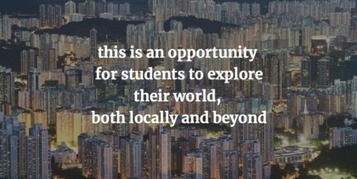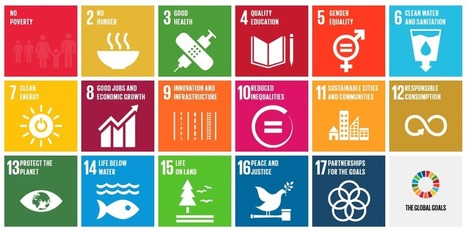 Your new post is loading...
Introduction
The link between fossil fuel reserves and war has been a clear pattern for decades, yet equally many violent conflicts and wars have already been fought over the access to water. Water is already a very scarce resource and at the same time as water is wasted and contaminated at a gigantic scale there are still a seventh of the world’s population without access to a safe water supply. There are serious issues with the world’s water and the systems we have designed to manage and care for water are deeply insufficient.
25 million people die each year from contaminated water. That is equivalent to the population of Canada
Every 8 seconds a child dies from contaminated water.
1.4 billion people have no access to safe drinking water.
2.4 billion people have no access to sanitary systems -one person in three.
(From Troubled Water by Anita Roddick and Brooke Shelby Biggs, 2004)
Editor's Note: Teachers around the world are tackling the UN Sustainable Development Goals (SDGs) in their classrooms. In this post, Craig Perrier, High School Curriculum and Instruction Specialist for Social Studies, Fairfax County Public Schools, shares ideas on how to address Goal 11: Sustainable Cities and Communities. Join Craig for #Globaledchat on Twitter this Thursday, March 1 at 8pm Eastern time, to more deeply discuss how to teach SDG 11.
By guest blogger Craig Perrier
I clearly remember when I first heard the news that the majority of the world's population now lives in urban areas for the first time in human history. It was 2007, and I was teaching high school in Massachusetts. To a world history teacher, this was a significant turning point. Minus some major catastrophe, this trend seems irreversible. Using a collage of urban images from both reality and science fiction films (such as Blade Runner, Brazil, and Star Wars), I shared the news and used it as an opportunity for students to explore their world, both locally and beyond.
Global competence is the capacity to examine local, global and intercultural issues, to understand and appreciate the perspectives and world views of others, to engage in open, appropriate and effective interactions with people from different cultures, and to act for collective well-being and sustainable development.
In 2015, 193 countries committed to achieving the 17 Sustainable Development Goals (SDGs) of the United Nations, a shared vision of humanity that provides the missing piece of the globalisation puzzle. The extent to which that vision becomes a reality will in no small way depend on what is happening in today’s classrooms. Indeed, it is educators who hold the key to ensuring that the SDGs become a real social contract with citizens.
Goal 4, which commits to quality education for all, is intentionally not limited to foundation knowledge and skills, such as literacy, mathematics and science, but emphasises learning to live together sustainably. This has inspired the OECD Programme for International Student Assessment (PISA), the global yardstick for success in education, to include global competence in its metrics for quality, equity and effectiveness in education. PISA will assess global competence for the first time ever in 2018.
PISA conceives of global competence as a multidimensional, lifelong learning goal. Globally competent individuals can examine local, global and intercultural issues, understand and appreciate different perspectives and world views, interact successfully and respectfully with others, and take responsible action toward sustainability and collective well-being.
It is worth looking at these four dimensions in some more detail.
We have an obligation to alert and empower young people to address these challenges and create new ways of engaging with the world and its people.
Download your own copy as a PDF to print on card from here
On Oct. 24, a panel of experts, including Phil Oxhorn, McGill’s Associate Provost (International), will examine the contribution of the private sector in regards to the UN’s sustainable development goals.
“Wake up, Monsieur le Comte! You have great things to do.” Those are the words, which, uttered by his personal valet every morning, would rouse the celebrated 19th century thinker, Henri de Saint S…
Fashion is a key component of a global economy and certainly an important sector to consider when thinking about the UN’s 17 Sustainable Development Goals (SDGs). Most remarkably, a new exhibit in New York at Museum of Modern Art (MOMA) explores just this.
|
Finding one single missing child can be difficult. So imagine trying to find millions of children who are living completely under the radar with no formal record of their existence. This is the challenge that we in the global health community now face as we try to protect every child from vaccine-preventable infectious disease. With one in four children born without being registered, it is an identity crisis that now represents one of the biggest barriers to achieving our development goals; a problem so systemic that nothing short of a Copernican revolution within global health is likely to fix it.
What is global competence?
Global competence is the capacity to examine local, global and intercultural issues, to understand and appreciate the perspectives and world views of others, to engage in open, appropriate and effective interactions with people from different cultures, and to act for collective well-being and sustainable development.
t Fleet primary school in north London, children between the ages of three and 11 are learning songs about climate change and the environment. Tunes featuring fossil fuels, composting, growing vegetables and the impact of transport have all become popular in class, despite the somewhat serious messages at their heart.
For the teachers, music is proving to be a useful tool in explaining subjects that may otherwise be considered complex or inaccessible for young children. “The kids love singing about green issues,” says Beth Cleine, head of science and arts at the school. “They learn simple, catchy songs and sing them in the classroom or all together in assembly. It’s a fun way to learn.” The children performed some of the songs at last year’s Camden Music Festival at the Royal Albert Hall.
This mantra in the SDG framework shows the clear intention that the fruits of achieving the SDGs should be shared equitably. Meeting the goals means meeting them for everyone, not just on average. Expressed like that, it is certainly a laudable ambition.
Certain dimensions of “no one left behind” are laid out in the framework. These include income, sex, age, race, ethnicity, migratory status, disability and geographic location, in accordance with the UN’s Fundamental Principles of Official Statistics. The principles lay out the framework for the collection, analysis and dissemination of official statistics.
But this masks a conceptual problem. As theorists of official statistics have noted the classifications and categories employed in official statistics are themselves “named into existence”. The act of not classifying or categorising certain groups can render them invisible in official statistics.
The SDG Academy creates and curates free, graduate-level courses on sustainable development for students around the world.
From sustainable cities to human rights to climate action, each of our courses addresses the fundamental challenge facing our world today: How do people, communities, governments and companies not only coexist, but also cooperate and collaborate, to save the one planet we have?
As a massive open online education platform, SDG Academy's courses are fully interactive, so you can meet, debate and learn from both our global faculty of sustainable development experts and your fellow students.
Learn more here about the SDG Academy – an initiative of the Sustainable Development Solutions Network – and the SDG Academy student experience.
With the United Nations Sustainable Development Goals (UN SDGs) fully coming into force in January 1, 2016, it was no surprise that the session at SB’17 Detroit on Aligning Corporate Strategy and…
This post by Julie Raymond is part a series from the members of the AAA delegation at the UN Climate Change Conference in Bonn, Germany. In 2015, the United Nations General Assembly adopted the Sustainable Development Goals (SDG’s). The 17 SDG’s are a road map intended to guide action that balances human needs with environmental…
Singapore leads the 188 countries while Afghanistan comes in last in meeting health-related Sustainable Development Goals.
When I give talks these days, I usually wear a pin—the O in the United Nation’s Sustainable Development GOals (SDGs). These were authorized by the U.N. General Assembly in 2015 to be a…
Do you know all 17 of the sustainable development goals adopted by the UN in January of 2016? If so, good for you. Up until today, I was mainly familiar with SDG 5: "Achieve gender equality and empower all women and girls." Now that I read Equal Measures 2030's research showing that many policy leaders in the……
|

 Your new post is loading...
Your new post is loading...
























